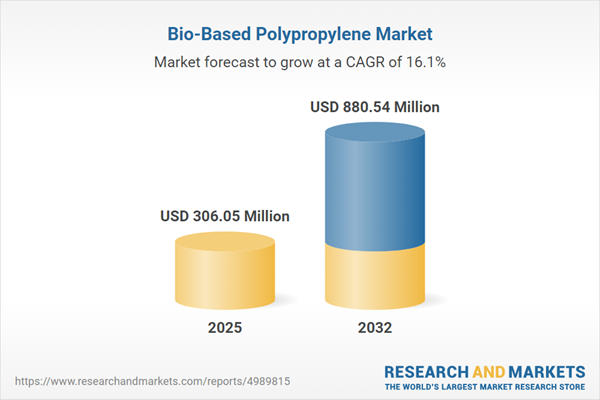Speak directly to the analyst to clarify any post sales queries you may have.
Bio-based polypropylene is increasingly central to strategic procurement, helping senior decision-makers advance sustainability, compliance, and operational stability within global supply chains. As organizations look to strengthen competitive positioning under evolving regulatory environments, this material supports both innovation and long-term business resilience.
Market Snapshot: Bio-Based Polypropylene Market Trends and Outlook
The bio-based polypropylene market is projected to reach USD 306.05 million by 2025, growing from a base of USD 266.11 million in 2024 and demonstrating a compound annual growth rate of 16.13%. Key drivers of this expansion include rising adoption in automotive, packaging, and consumer goods sectors, which are aligning procurement decisions with sustainability objectives and strict regulatory standards. Shifts in procurement frameworks emphasize greater transparency, requiring decision-makers to focus on value chain oversight while supporting broader industry innovation. Organizations are also exploring alternative feedstocks to enhance their strategic material portfolios. These factors collectively push leaders to address new challenges in supply agility, regulatory alignment, and security of sourcing within a more dynamic operational landscape.
Scope & Segmentation: Bio-Based Polypropylene Market
- Source Types: Plant residues, wood pulp, corn derivatives, and sugarcane enable companies to address diverse functional requirements and specialized application demands.
- Production Techniques: Catalytic, enzymatic, fermentation, and thermal methods are employed to advance efficiency and promote sustainable outcomes across major industries.
- Applications: Extrusion coating, injection molding, blow molding, fiber production, and film and sheet development offer manufacturers versatility to support a broad spectrum of product objectives.
- End Use Industries: Automotive, construction, electronics, packaging, and consumer goods brands are actively transitioning towards bio-based polypropylene, enabling compliance, enhancing recovery, and meeting updated material expectations.
- Regions Analyzed: The market comprises the Americas, Europe, Middle East, Africa, and Asia-Pacific. Each presents unique sourcing and regulatory considerations, prompting organizations to devise region-specific supplier engagement strategies and sustainability initiatives.
- Companies Profiled: Leading sector participants include Avient Corporation, BASF SE, Biokunststofftool, Borealis AG, Braskem S.A., Covestro AG, Dow Chemical Company, Emballator Group, FKuR Kunststoff GmbH, LG Chem Ltd., LyondellBasell Industries N.V., Mitsui Chemicals, Inc., Neste Oyj, Reliance Industries Limited, SABIC, Sumitomo Chemical Ltd., and TotalEnergies SE. These firms are actively contributing to greater resilience throughout the supply chain.
Key Takeaways for Senior Decision-Makers
- Adoption of renewable feedstocks strengthens procurement strategies by increasing supply adaptability to evolving market and regulatory conditions.
- Collaborative partnerships among licensors, suppliers, and brands facilitate seamless integration of advanced materials and streamline compliance with global standards.
- Clear certification protocols and circular economy principles enhance traceability, improving compliance governance across geographically complex operations.
- Regional sourcing diversification improves operational flexibility, supporting stability and rapid adaptation to shifting priorities in sustainability and regulations.
- Investing in workforce development and building supplier relationships at the local level accelerates responsiveness to changes in compliance and resource availability.
Tariff Impact on Transboundary Supply Chains
Recent tariff adjustments in the United States are prompting businesses to reassess sourcing strategies for bio-based polypropylene. Increased attention to nearshoring and development of local supplier networks supports greater agility and secures access to essential materials. Manufacturers in fiber and blow molding applications benefit from streamlined processes and are better positioned to adapt as trade environments fluctuate, protecting efficiency across borders amid regulatory change.
Methodology & Data Sources
This report draws on interviews with technology suppliers and feedstock experts, patent analysis, and comprehensive lifecycle assessment studies. Regional market data, combined with regulatory framework evaluations, clarify the key drivers and operational challenges shaping the bio-based polypropylene sector.
Why This Report Matters for Senior Procurement and Operational Leaders
- Facilitates creation of scalable sourcing models as bio-based polypropylene emerges as a critical supply chain component.
- Enables leadership to identify optimal supplier partners, guide investments, and enhance compliance programs in response to regulatory shifts.
- Provides practical insights for designing resilient, future-ready operations in markets with rapidly evolving standards.
Conclusion
Utilizing bio-based polypropylene helps organizations achieve sustainability, meet regulatory obligations, and maintain operational resilience. This report informs strategic decisions for supply chain agility and leadership adaptability in a changing global market.
Additional Product Information:
- Purchase of this report includes 1 year online access with quarterly updates.
- This report can be updated on request. Please contact our Customer Experience team using the Ask a Question widget on our website.
Table of Contents
3. Executive Summary
4. Market Overview
7. Cumulative Impact of Artificial Intelligence 2025
List of Figures
Companies Mentioned
The companies profiled in this Bio-Based Polypropylene market report include:- Avient Corporation
- BASF SE
- Biokunststofftool
- Borealis AG
- Braskem S.A.
- Covestro AG
- Dow Chemical Company
- Emballator Group
- FKuR Kunststoff GmbH
- LG Chem Ltd.
- LyondellBasell Industries N.V.
- Mitsui Chemicals, Inc.
- Neste Oyj
- Reliance Industries Limited
- SABIC
- Sumitomo Chemical Ltd.
- TotalEnergies SE
Table Information
| Report Attribute | Details |
|---|---|
| No. of Pages | 186 |
| Published | November 2025 |
| Forecast Period | 2025 - 2032 |
| Estimated Market Value ( USD | $ 306.05 Million |
| Forecasted Market Value ( USD | $ 880.54 Million |
| Compound Annual Growth Rate | 16.1% |
| Regions Covered | Global |
| No. of Companies Mentioned | 18 |









